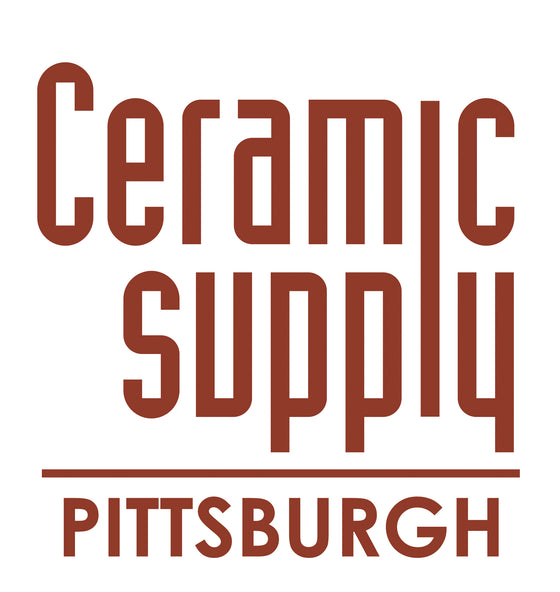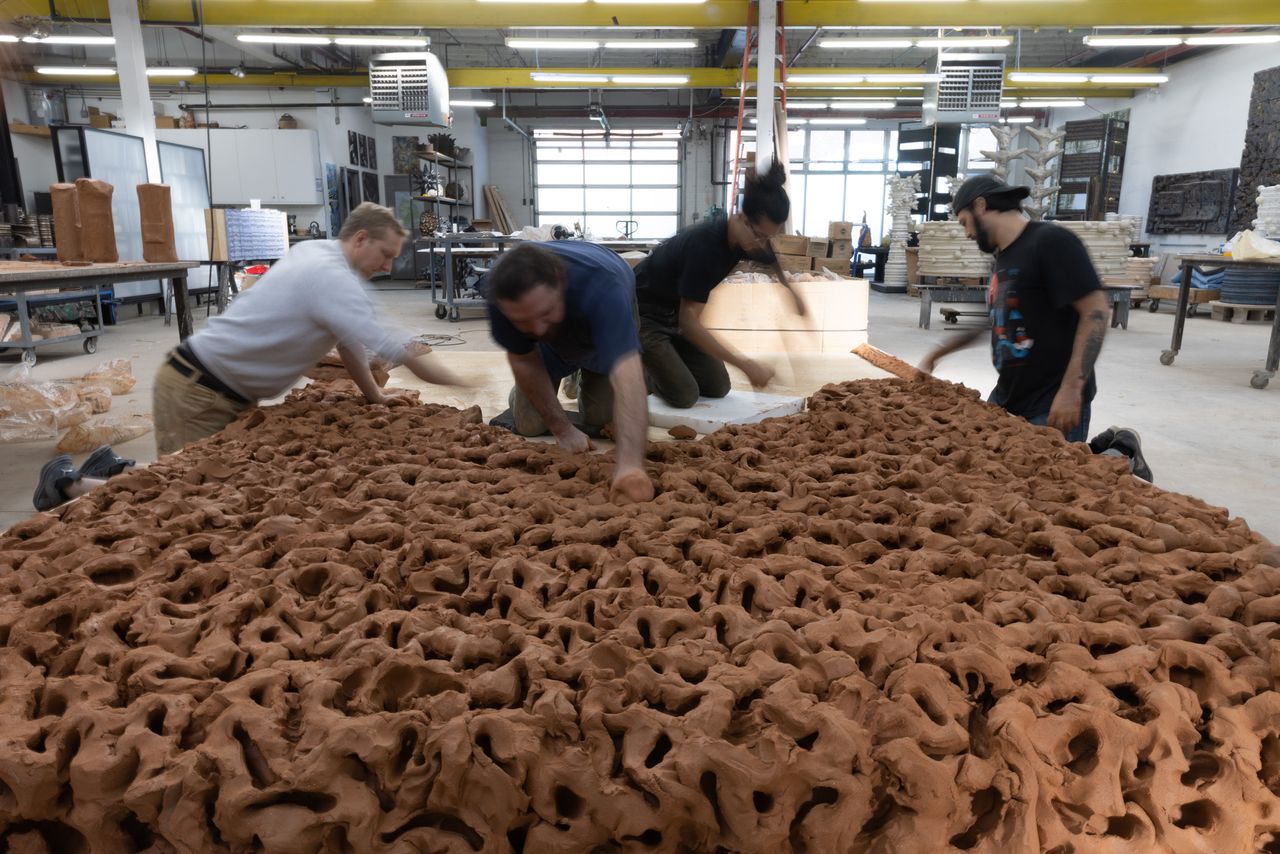Peter Lane: Transformation of Earth
August 13, 2025

Peter Lane: Transformation of Earth

The scene at Peter Lane’s Scholes Street studio in Brooklyn looks like a mother’s nightmare – a group of boys on their hands and knees, pants and sleeves stained brown, a massive pile of mud. But these aren’t boys and this is not mud. They are Lane’s team of ceramicists and this is clay. The group is working on a huge architectural installation for a client. This New York based ceramic artist works on an unprecedented scale, creating architectural features for private and commercial spaces, along with furniture and decorative work. His fidelity to the nature of clay guides the process and the finished work, as he manipulates the material through a journey that magnifies its most essential elements in the final product.
Lane describes his route into ceramics as unplanned and accidental. He and a friend were at a flea market in Miami in the 1990s, noting some decorative pottery pieces. “We were commenting on how these pieces used to cost 25 cents in the 1980s and now they go for 25 dollars. We randomly said, ‘Let’s take a pottery class!’ and that’s how it started. I fell in love and never looked back.”
accidental. He and a friend were at a flea market in Miami in the 1990s, noting some decorative pottery pieces. “We were commenting on how these pieces used to cost 25 cents in the 1980s and now they go for 25 dollars. We randomly said, ‘Let’s take a pottery class!’ and that’s how it started. I fell in love and never looked back.”
Lane settled into the clay program at Greenwich House in New York City with ease, taking classes, becoming an assistant, and ultimately having his own studio there. He says that Greenwich House is only one example of how accessible instruction in ceramics is in this country. “There is no formal process; it’s not a program; it’s there for anyone who cannot or does not want to get it together to apply for formal education.” Lane’s enthusiasm (he calls it obsession) found unlimited opportunity.
While at Greenwich House, Lane took advantage of the many weekend workshops presented by noted visiting artists. He found his muse at a workshop by Annabeth Rosen, the Robert Arneson Endowed Chair in Ceramic Sculpture at UC Davis. “I loved her big, crunchy pieces that look like they’ve been slapped together,” he explains. “She doesn’t worry about thickness or exploding and isn’t afraid to break all the rules. The way she uses clay greatly influenced me.”
 Lane claims not to start with esoteric concepts. “I have had clients from the beginning,” he says. He tells of an architect friend who had a client who wanted ceramic lamps. He asked Lane if he could make them. “I wasn’t interested at first,” he recalls, “but when he
Lane claims not to start with esoteric concepts. “I have had clients from the beginning,” he says. He tells of an architect friend who had a client who wanted ceramic lamps. He asked Lane if he could make them. “I wasn’t interested at first,” he recalls, “but when he  offered me $500 each, I changed my mind!” With friends and connections in the interior design and architecture fields, he soon was receiving commissions for lamps, tables, and furniture and began to develop his signature style.
offered me $500 each, I changed my mind!” With friends and connections in the interior design and architecture fields, he soon was receiving commissions for lamps, tables, and furniture and began to develop his signature style.
When a client wanted a frame for a mirror, Lane transitioned to wall pieces. “It was a difficult process,” he explains. “It was a nightmare trying to get the heavy clay attached to the armature that would hold the glass. I tried gluing bolts into plywood, but it was so impractical, I didn’t want to pursue it. Then I had the idea of making holes in the actual work itself, where the screws could go through and attach right to the wall. I made rectangular modules, putting holes all over it. When it came out of the kiln, it was a eureka moment.” Lane doesn’t use bolts in every hole, allowing the holes to blend into the look of the piece.
wall pieces. “It was a difficult process,” he explains. “It was a nightmare trying to get the heavy clay attached to the armature that would hold the glass. I tried gluing bolts into plywood, but it was so impractical, I didn’t want to pursue it. Then I had the idea of making holes in the actual work itself, where the screws could go through and attach right to the wall. I made rectangular modules, putting holes all over it. When it came out of the kiln, it was a eureka moment.” Lane doesn’t use bolts in every hole, allowing the holes to blend into the look of the piece.
Lane soon had a commission for doing an entire wall in a pool house in Miami. He says, “It was a huge learning curve, with the early pieces, but now, with years of experience, it is a well-oiled machine. He uses the original hole system on much bigger works. He creates the design on paper and divides it into individual sections. The entire work is created on the studio floor, using a grid system. The individual pieces are cut and fired. Because the work is so physically hard and monumental in scale, Lane employs a team of assistants to simultaneously work on the wet clay sections, following Lane’s design. His assistants are talented artists, many from Greenwich House, whom Lane supports and encourages.


The scale of Lane’s work demands a large working space. From his beginnings at his Greenwich House studio, he moved on to manage a studio space in Carol Gardens. Its 500 square feet soon became too small, and Lane rented space from the late Arnold Zimmerman in Williamsburg. When that neighborhood was gentrified and became too expensive, Lane moved to the Scholes Street location in the Bushwick section of Brooklyn, where he has 13,000 square feet to accommodate his massive works and the multiple tons of clay he orders from Standard through Ceramic Supply Inc. He says, “I could move out of the city, upstate or to Pennsylvania, to save on rent, but I want to be near my clients. Even designers from Paris, London, and L.A. are in the city and want to do business here.”
Street location in the Bushwick section of Brooklyn, where he has 13,000 square feet to accommodate his massive works and the multiple tons of clay he orders from Standard through Ceramic Supply Inc. He says, “I could move out of the city, upstate or to Pennsylvania, to save on rent, but I want to be near my clients. Even designers from Paris, London, and L.A. are in the city and want to do business here.”
While Lane is certainly a successful businessman, he is primarily an artist. His recently completed monograph opens with his favorite quotation from Willa Cather’s The Song of the Lark. In brief:
What is any art but an effort to make a sheath, a mold in which to imprison for a moment the shining, elusive element which is life itself…
Lane says that this statement struck him as profound, speaking to the way working with clay evokes a natural response to the material, a touch that reveals the maker’s mark, a moment of capturing an element of the earth and our life within it. He says that clay has a mind of its own: “You cook it and see what comes up, something that wasn’t there before.” Those who experience Lane’s creations, installed in spaces that are transformed, cannot help but find in their beauty the path back to the clay, the mud from the earth.


Learn more at www.peterlaneclay.com
Peter Lane’s Clay is available for purchase exclusively at www.scholespress.com




 accidental.
accidental. Lane claims not to start with esoteric concepts.
Lane claims not to start with esoteric concepts. offered me $500 each, I changed my mind!”
offered me $500 each, I changed my mind!” wall pieces.
wall pieces.

 Street location in the Bushwick section of Brooklyn, where he has 13,000 square feet to accommodate his massive works and the multiple tons of clay he orders from Standard through Ceramic Supply Inc.
Street location in the Bushwick section of Brooklyn, where he has 13,000 square feet to accommodate his massive works and the multiple tons of clay he orders from Standard through Ceramic Supply Inc.

